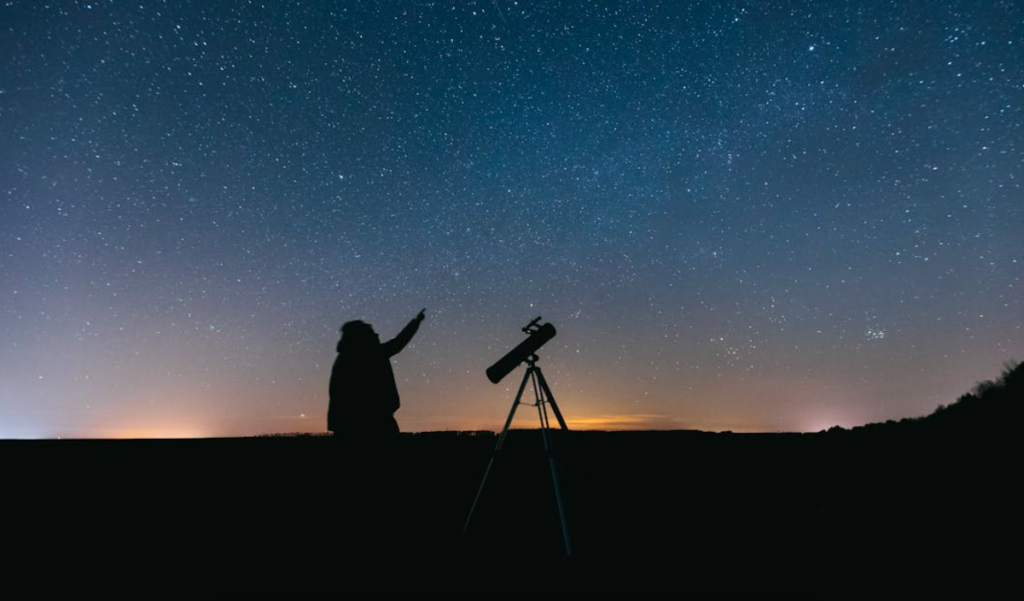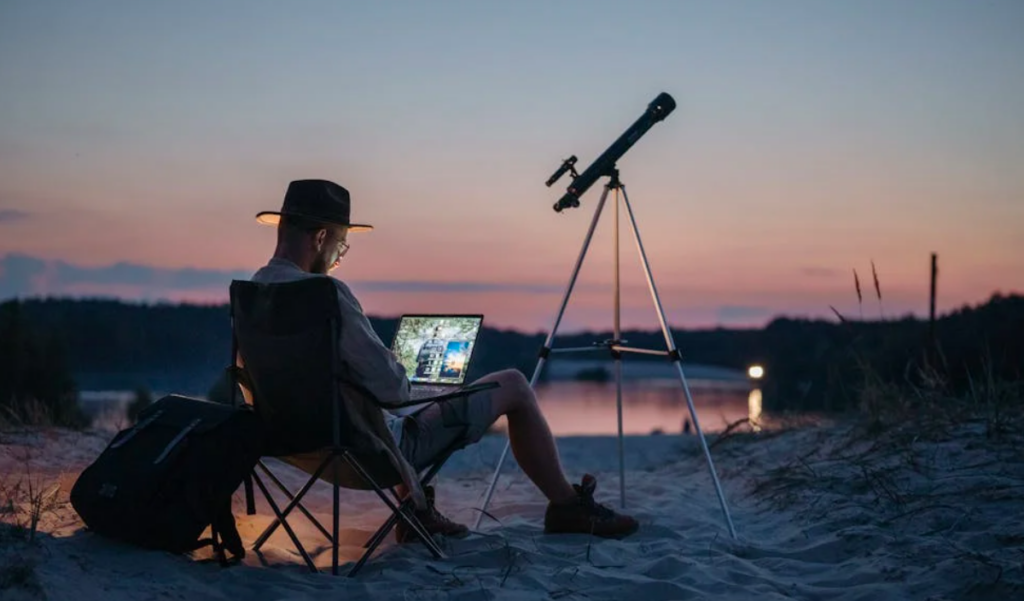Astral Marvels: Stargazing in Cape Lookout and Emerald Isle
Discover the magic of North Carolina’s night skies: Cape Lookout’s Dark Sky Park and Emerald Isle’s best stargazing spots await your gaze.
Stargazers vacationing in Emerald Isle or along the Outer Banks, rejoice! In 2021, the amazing Cape Lookout National Seashore was certified as an International Dark Sky Park, the first Atlantic coastal Dark Sky Place in the National Park Service to receive this designation. Since then, this North Carolina treasure has been attracting even more visitors eager to experience dark, magical skies.
If you’re vacationing on Emerald Isle, visiting Cape Lookout National Seashore and experiencing its clear, starry skies is something you should definitely include in your NC bucket list. The drive isn’t exactly short, we know. But trust us — the two-hour journey to witness a true celestial wonder will be worth every single minute.
In this blog, we’ll tell you all about Cape Lookout National Seashore’s designation as an International Dark Sky Park and what to expect from stargazing there. Plus, we’ll share other spots for stargazing on Emerald Isle.
About Us
At Spinnaker’s Reach, we provide a fantastic selection of short-term rentals in Emerald Isle, North Carolina, including options with pools and pet-friendly accommodations. For great insider tips on Emerald Isle, check out our destination blog. We cover everything about the region, including tips for a romantic getaway, a guide to fishing, and the best day trips you can take from Emerald Isle.
Get ready for a stellar adventure — and let’s look up! 💫

New to Stargazing? Step Into the Magic of the Night Sky.
Not familiar with stargazing? We’re here to introduce you to this incredible outdoor activity. For those who don’t know about it they might think it’s just looking at the sky and admiring the stars.
Well, that’s not wrong, but there’s much more to it!
Stargazing is the act of observing the night sky to view celestial objects such as stars, planets, the Moon, meteors, and even deep-sky objects like galaxies and nebulae. It can be done with the naked eye, binoculars, or telescopes and is often enjoyed in locations with minimal light pollution conditions for the best visibility.
Stargazing can be a casual, relaxing activity — simply lying on a beach and watching the stars — or a more structured pursuit, involving tracking astronomical events like meteor showers, eclipses, or planetary alignments. Besides, many people also engage in astrophotography to capture the beauty of the cosmos.
Cape Lookout National Seashore: A Certified International Dark Sky Park
What does it mean to be a certified International Dark Sky Park?
Cape Lookout National Seashore being certified as an International Dark Sky Park (IDSP) means that it has been recognized for its exceptionally dark and star-filled night skies, free from excessive light pollution. This designation is granted by the International Dark-Sky Association and signifies that the park is dedicated to preserving and protecting its natural nighttime environment.
What does this mean for stargazers?
- Minimal Light Pollution: The park maintains strict lighting regulations to reduce artificial light, ensuring clear, unobstructed views of celestial events.
- Ideal Conditions for Astronomy: With little interference from city lights, visitors can see the Milky Way, meteor showers, planets, and deep-space objects more vividly.
- Special Stargazing Events: Cape Lookout often hosts astronomy nights and educational programs where visitors can observe the night sky through telescopes with guidance from experts.
- Conservation Efforts: The park commits to preserving nocturnal habitats for wildlife by minimizing artificial lighting, helping species that rely on natural darkness.
What to expect?
No matter if it is your first time stargazing or an activity you’ve been doing for years, expect a truly celestial wonder.
Milky Way Galaxy ✨
From April to October, the Milky Way Galaxy becomes a breathtaking feature in the night sky over Cape Lookout National Seashore. With minimal light pollution, the galaxy’s dense clusters of stars stretch across the horizon, creating a spectacular celestial display visible to the naked eye.
Meteor Showers ☄️
Meteor showers provide another dazzling sight, with two of the most famous occurring at different times of the year. The Perseids, peaking in August, are among the brightest and most anticipated meteor showers, often producing dozens of shooting stars per hour. In December, the Geminids take center stage, offering one of the best opportunities for winter stargazing, with bright, multi-colored meteors streaking across the sky.
Planets & Constellations 🪐
Several planets and constellations are easily visible throughout the year. Jupiter and Saturn, two of the largest planets in the solar system, frequently shine brightly, even without a telescope. Orion’s Belt, a trio of stars forming part of the Orion constellation, is a striking feature of winter nights. Meanwhile, summer skies are dominated by the Summer Triangle, a formation made up of the stars Vega, Altair, and Deneb, marking some of the season’s most prominent constellations.
Bioluminescence 😍
It’s not all about looking up! Adding to the magic, visitors may occasionally witness bioluminescence in the waters near the shore, particularly during the summer months. Bioluminescent plankton emit a soft, glowing light when disturbed, creating an otherworldly effect that mirrors the twinkling stars above. When conditions are right, the combination of a star-filled sky and glowing ocean waves makes for an unforgettable experience.
Best times for stargazing
- New Moon Nights: Avoid full moon nights, as the brightness can wash out fainter stars.
- After Midnight: This is when the sky is darkest, and celestial objects appear at their best.
- Cooler Months: Fall and winter often have clearer skies due to lower humidity.
What to bring
- Telescope or Binoculars: Ideal for viewing planets and deep-sky objects.
- Red Flashlight: Preserves night vision while navigating.
- Blankets & Chairs: Lying on the beach enhances the experience.
- Camera: A DSLR or mirrorless camera with long exposure settings can capture stunning astrophotography.
- Bug Spray: Especially necessary in warmer months.
- Warm Clothing: Nights can be chilly, even in summer.
Cape Lookout Lighthouse Special tours & Programs
Cape Lookout National Seashore offers special stargazing tours and events, often in collaboration with local organizations. Here are some notable opportunities:
- Starlight Cruises to Cape Lookout Lighthouse: Embark on an evening ferry ride to the Cape Lookout Lighthouse, where professional guides provide a laser-guided tour of the night sky. Organized by Island Express Ferry Service, the cruise departs from the Cape Lookout Visitor Center at 1800 Island Road on Harkers Island. Reservation is required and spots fill up quickly.
- Crystal Coast Star Party: An annual event celebrating International Dark Sky Week, featuring starlight cruises, public stargazing sessions, and educational presentations. Highlights include evening trips to Cape Lookout Lighthouse with guided night sky tours, public stargazing with telescopes set up around the Cape Lookout Visitor Center for communal viewing, and presentations by NASA speakers and astronomy activities for all ages.

Best Places for Stargazing on Emerald Isle
Beyond Cape Lookout National Seashore, there are other incredible places for stargazing on Emerald Isle and around. Here are some of the most popular spots for a magical starry night:
The Point
The westernmost tip of Emerald Isle, known as The Point, is one of the best locations for stargazing due to its unobstructed views of the night sky over the ocean and Bogue Inlet. With minimal artificial lighting and fewer crowds, it’s an ideal place to set up a telescope or simply lay back and take in the stars.
Emerald Isle Beach Access Areas
Several public beach access points along Emerald Isle offer great stargazing conditions. These areas provide wide, open spaces with minimal interference from streetlights. Some of the best spots are Third Street Beach Access (off Ocean Drive), Western Ocean Regional Access (9102 Coast Guard Rd), and Eastern Ocean Regional Access (2701 Emerald Dr).
Bogue Inlet Fishing Pier
While some artificial lighting exists near the pier, stepping further down the beach in either direction can provide a darker, more immersive view of the night sky. The ocean’s reflection also enhances the stargazing experience.
Emerald Isle Woods Park
For an even darker sky experience, take a short trip to Hammocks Beach State Park on the mainland. The park’s ferry-accessible Bear Island offers nearly zero artificial light, making it one of the best stargazing locations near Emerald Isle.
Your Vacation Rental (Alternative Option)
Prefer to stay close to home? Some vacation rentals with spacious backyards and quiet beachfront locations offer incredible stargazing opportunities. Far from city lights, these serene retreats provide the perfect setting to unwind under a brilliant night sky. Whether you’re relaxing on the deck or taking a moonlit stroll along the shore, the minimal light pollution ensures breathtaking celestial views.

Bonus: How to Get Started with Stargazing: A Quick Beginner’s Guide
Stargazing is an accessible activity that requires little to no equipment. If you’re drawn to the beauty of the night sky or eager to explore beyond, here’s how to start.
- Find a Dark Location: The farther you are from city lights, the better the view. Light pollution washes out fainter stars and celestial objects. National parks, beaches, and rural areas offer the best conditions. If you’re near the coast, places like Cape Lookout National Seashore or Emerald Isle are ideal. You can use light pollution maps (such as Dark Sky Finder or LightPollutionMap.info) to locate the darkest areas near you.
- Check the Weather and Moon Phases: A clear, cloudless night is essential for good visibility. A new moon or nights when the moon is less bright provide darker skies for seeing fainter objects. apps like Clear Outside or Weather.gov can help you plan ahead.
- Start with the Naked Eye: No telescope? No problem! Your eyes can see thousands of stars, planets, and even the Milky Way in dark locations. Look for constellations like Orion, the Big Dipper, or Cassiopeia as reference points. Watch for meteors, especially during annual showers like the Perseids (August) and Geminids (December).
- Use a Stargazing App or Star Chart: Apps like SkySafari, Stellarium, Night Sky, or SkyView help identify stars, planets, and constellations in real time. A printed star map or planisphere is useful if you prefer a tech-free experience.
- Be Patient and Let Your Eyes Adjust: Your eyes take about 20–30 minutes to fully adjust to the darkness. Avoid looking at bright screens or lights to enhance your ability to see faint celestial objects.

Experience Emerald Isle and the Sky Like Never Before
Experience Emerald Isle like a local by staying in a short-term rental. At Spinnaker’s Reach Realty, we have an amazing selection of properties offering the perfect combination of privacy, stunning coastal views, and a cozy atmosphere, ensuring a truly relaxing getaway and a five-star experience on Emerald Isle.
